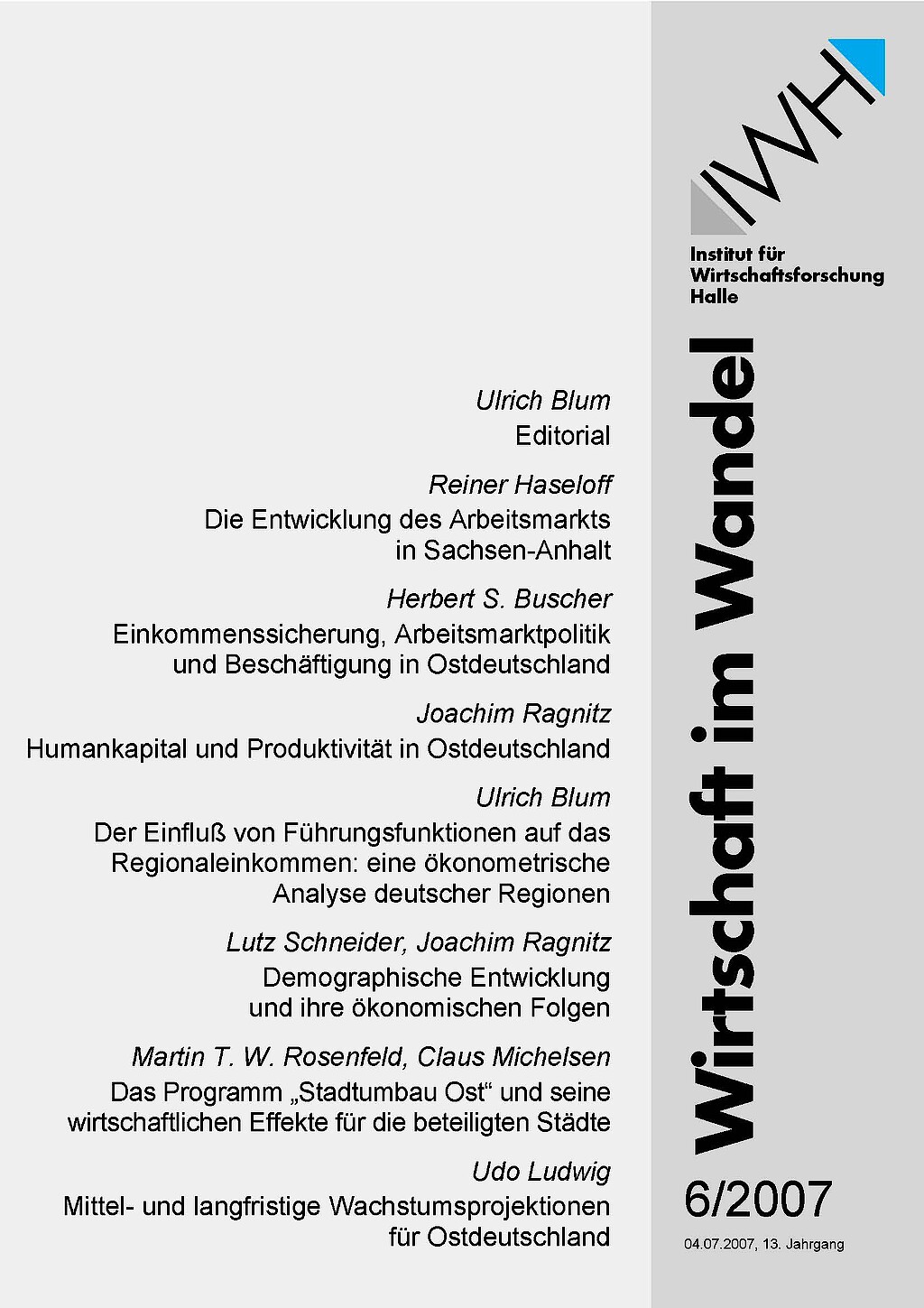
Long-Term Growth Projections for Eastern Germany
In jüngster Zeit attestieren einige Forschungsergebnisse dem Osten Deutschlands nicht nur seine „Qualität“ als wirtschaftlich abgehängte Region von Wachstum und Wohlstand, sondern bereits den „langsamen Tod“. Häufig wird in diesem Zusammenhang auf die Strukturschwächen der ostdeutschen Wirtschaft verwiesen, die von De-Industrialisierung über fehlende Konzernzentralen bis hin zu Rückgang und Vergreisung der Bevölkerung reichen. Dieser Beitrag geht davon aus, daß die wirtschaftliche Entwicklung einer Region nicht allein von der Quantität und Qualität der Ausstattung des jeweiligen Wirtschaftsraums mit Produktionsfaktoren abhängt, sondern zugleich von der gesamtwirtschaftlichen Entwicklung der übergeordneten Ebene, der nationalen Volkswirtschaft, determiniert wird. Dazu bedient er sich eines Forschungsansatzes, in dem der regionale Faktorinput aus Datengründen auf die Bevölkerung (Arbeitsangebot) und ihre Dynamik reduziert und der Produktionsoutput auf die Wertschöpfung in der Region konzentriert wird. Zudem wird wegen der Kürze des Stützzeitraums für die Untersuchung (1995 bis 2005) ein panelökonometrischer Ansatz gewählt, der neben den Längsschnittdaten mittels der Konstruktion von Raumklassen deren Querschnittsdimension berücksichtigt. Dazu werden die 97 Raumordnungsregionen in Deutschland zu vier Wachstumsklassen gruppiert: je eine wachstumsstarke und eine wachstumsschwache Raumklasse sowie zwei mittlere Raumklassen. Zu den beiden wachstumsstärkeren Raumklassen gehören auch bis zu neun Raumordnungsregionen in Mitteldeutschland und im Land Brandenburg. Die Parameter der Schätzgleichungen zeigen die erwarteten Vorzeichen. Danach erhöhen sowohl ein Anstieg der Produktion in Deutschland als auch eine Zunahme der regionalen Bevölkerung die regionale Wertschöpfung. Bei rückläufiger Einwohnerzahl wird die Wirtschaftsleistung in den Regionen gebremst. Der Einfluß der gesamtwirtschaftlichen Produktion auf nationaler Ebene ist in der oberen Wachstumsklasse am stärksten, in der unteren am schwächsten. Genau umgekehrt wirkt sich die vorangegangene Entwicklung in der Region aus. Ihr Einfluß ist am stärksten in der wachstumsschwachen Raumklasse. Hauptergebnis der Untersuchung ist: Das Wirtschaftswachstum in einer Region wird sich auch bei schrumpfender Bevölkerung fortsetzen. Die mit der demographischen Entwicklung verbundene Alterung der Gesellschaft wird in Deutschland bis zum Jahr 2020 nur wenig auf Wachstum und Beschäftigung durchschlagen. Allerdings wird sich die Zuwachsrate des Bruttoinlandsprodukts in Deutschland nach dem Jahr 2020 verringern. Zugleich wird sich das wirtschaftliche Gefälle zwischen den Regionen nicht einebnen. Die wachstumsstarken Regionen in den alten Bundesländern werden auch bei abnehmender gesamtwirtschaftlicher Expansion überdurchschnittliche Produktionszuwächse erzielen. Dies gilt auch für einige Raumordnungsregionen im Land Brandenburg und in Mitteldeutschland. Dagegen werden die Produktionszuwächse in den wachstumsschwachen Regionen im Norden, in der Mitte und im Osten Deutschlands hinter dem Durchschnitt zurückbleiben. Insgesamt geht die Divergenz beim Wachstumstempo der Produktion zwischen dem Osten und dem Westen Deutschlands mit Bevölkerungsentwicklungen einher, die einer Vergrößerung des Abstands in der Pro-Kopf-Produktion entgegenwirken.




